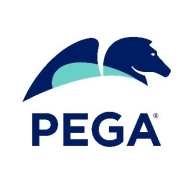


Find out what your peers are saying about Camunda, Automation Anywhere, SAP and others in Business Process Management (BPM).
The customer service is outstanding.
We had a contract that provided on-site support, which was very satisfactory.
On a scale from 1 to 10, support deserves a rating of 7 to 8.
The technical support from Pega is very low, rating a one or two out of ten.
I never needed support from the platform standpoint, but if additional features are required, we have regular meetings with the product team for feedback.
Pega's technical support team is very helpful.
The architecture of the solution offers scalability; we can scale both vertically and horizontally.
The solution has scalability issues; on a scale, I would rate it at eight out of ten.
I found IBM BPM to be scalable to a certain level but it struggled with large volumes of concurrent transactions.
Currently, big banking providers and insurance providers, even the members for healthcare payers, are using more than millions of operations on a daily or weekly basis.
IBM BPM also lacks smaller solutions, so I must purchase multiple solutions to start with workflows and applications.
Although IBM BPM is a substantial product, adopting and integrating new technologies quickly is not easy due to the migration and upgrade paths involved.
Additionally, the deployment process should be easier.
With the recent development of AI agents in Pega Platform 24.2, the adoption is not heavy due to regulations around using external LLM by customers, especially regulated customers in BFSS and healthcare.
Pega introduced Constellation, which allows a user to build a more engaging visual experience.
My learning curve in robotics has been challenging.
SAP is more expensive, but IBM BPM is very expensive.
Nintex Process Platform is expensive.
Pega is priced higher than open-source options like Flowable but is suitable for large-scale industries like banking and insurance.
The pricing is expensive, and this is an issue.
From a licensing perspective, it is higher than the competition.
The integration capabilities of IBM BPM are excellent.
My team and I created a demo using Nintex, focusing on getting emails, reading, writing, and managing attachments.
Pega Platform is excellent for enterprise-level solutions with integrations to entire systems, including case management, service orchestration, CRM, decision-making capabilities, digital process automation, and AI-driven functionalities.
Management capabilities such as dashboards.
| Product | Market Share (%) |
|---|---|
| Pega Platform | 5.2% |
| IBM BPM | 5.9% |
| Nintex Process Platform | 1.9% |
| Other | 87.0% |



| Company Size | Count |
|---|---|
| Small Business | 30 |
| Midsize Enterprise | 19 |
| Large Enterprise | 71 |
| Company Size | Count |
|---|---|
| Small Business | 17 |
| Midsize Enterprise | 6 |
| Large Enterprise | 24 |
| Company Size | Count |
|---|---|
| Small Business | 9 |
| Midsize Enterprise | 15 |
| Large Enterprise | 68 |
IBM BPM is a business process management tool that provides a robust set of tools to author, test, and deploy business processes, as well as full visibility and insight to managing those business processes. The solution provides tooling and run time for process design, execution, monitoring, and optimization, along with basic system integration support. To support various levels of complexity and involvement with business process management, there are two different editions of the product: IBM BPM and IBM BPM Express.
IBM BPM Features
IBM BPM has many valuable key features. Some of the most useful ones include:
IBM BPM Benefits
There are many benefits to implementing IBM BPM. Some of the biggest advantages the solution offers include:
Reviews from Real Users
IBM BPM is a solution that stands out when compared to many of its competitors. Some of its major advantages are that it’s good for developing complex apps, is robust, and has helpful team management and process performance features.
Zoran C., Owner/CEO at IT SPHERE, says, “It is perfect if you have to develop complex apps without much coding (only java script). It is also good if you don't have much IT resources in your company and would like to involve business analysts in the process of developing apps. My opinion is that it can do about 50% of all developers' work.”
Suhas V., BPM Architect at GBM, mentions, “Overall the solution is robust and has the ability to integrate with any product for complex workflows."
A BPM Consultant at a financial services firm comments, "Some of the features that I like the most are team management and process performance. They are both very useful and very powerful with regard to the workflow."
A Digital Banking & Innovation Director at a financial services firm expresses, “The processing functionality makes it easy to change processes and workflows easily.”
Nintex Process Platform offers no/low-code development with system integrations and efficient workflow management, ideal for complex business processes. It's known for its scalable workflows, data management through SmartObjects, and a user-friendly visual designer.
Nintex Process Platform enables organizations to automate processes with ease, supporting electronic forms, digital transformation, and seamless department collaboration. Users on SharePoint and other integrated systems leverage its extensive workflow capabilities for approvals, onboarding, and information capture. While its current framework might benefit from performance enhancements and improved management console usability, it remains a strong choice for providing scalable solutions across industries.
What are the key features of Nintex Process Platform?Companies in sectors like government, HR, and financial services implement Nintex Process Platform for its ability to streamline and connect internal processes. It supports approval workflows, notifications, and data capturing, proving its versatility for diverse business needs. However, challenges with document conversion, performance, and cloud feature parity suggest room for enhancements, particularly in industries handling complex workflows.
Pega Platform provides flexible business process management with a focus on rapid application development and automation through a low-code approach, enhancing efficiency across sectors.
Pega Platform is renowned for its ability to streamline operations with robust automation features, including robotic process automation and decision-making capabilities. Its intuitive interface and workflow management contribute to a reputation for enhancing business processes. Although users face challenges with integration limitations and high licensing costs, they benefit from rapid deployment and efficient process adaptations. The unified architecture reduces complexity, while case management and integration services support digital transformations in sectors such as banking, insurance, and healthcare.
What are the key features of Pega Platform?In industries like insurance, banking, healthcare, and government, Pega Platform is implemented to automate diverse workflows, supporting initiatives from claims processing to customer onboarding. Enterprises use Pega for case management and digital transformations, valuing its out-of-the-box integrations and real-time reporting capabilities to boost operational automation and enhance customer experiences.